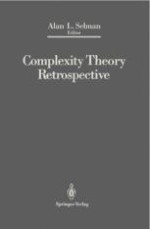1990 | Buch
Über dieses Buch
In 1965 Juris Hartmanis and Richard E. Stearns published a paper "On the Computational Complexity of Algorithms". The field of complexity theory takes its name from this seminal paper and many of the major concepts and issues of complexity theory were introduced by Hartmanis in subsequent work. In honor of the contribution of Juris Hartmanis to the field of complexity theory, a special session of invited talks by Richard E. Stearns, Allan Borodin and Paul Young was held at the third annual meeting of the Structure in Complexity conference, and the first three chapters of this book are the final versions of these talks. They recall intellectual and professional trends in Hartmanis' contributions. All but one of the remainder of the chapters in this volume originated as a presentation at one of the recent meetings of the Structure in Complexity Theory Conference and appeared in preliminary form in the conference proceedings. In all, these expositions form an excellent description of much of contemporary complexity theory.
Anzeige
